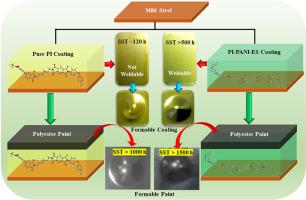A novel superior corrosion resistance and spot-weldable polyimide-polyaniline composite coating for low alloy mild steel
IF 4.7
3区 材料科学
Q2 MATERIALS SCIENCE, MULTIDISCIPLINARY
引用次数: 0
Abstract
In this work, we synthesized conducting polyaniline emeraldine salt (PANI-ES), which was subsequently used for the in-situ synthesis of a semiconducting, spot-weldable polyamic acid–PANI-ES (PAA–PANI-ES) composite coating. The PAA–PANI-ES coating was applied to mild steel using an automatic bar coater, which, upon drying, formed a uniform polyimide–PANI-ES (PI–PANI-ES) coating with a thickness of approximately 10 ± 2 μm. The PI–PANI-ES-coated steel substrates were spot-weldable, whereas substrates coated with pure PI were not spot-weldable, due to its insulating nature. We achieved superior corrosion resistance on mild steel substrates (>500 h, 5 % red rust) using the PI–PANI-ES coating, compared to ∼120 h (5 % red rust) for the pure PI coating. Both pure PI and PI–PANI-ES coating systems exhibited excellent adhesion to the mild steel substrate and successfully passed the required forming tests. Additionally, both types of coatings showed strong adhesion to polyester-based powder paint. The incorporation of conducting PANI-ES powder into the PI matrix enhanced the corrosion resistance and AC conductivity of the coating system. Owing to its excellent corrosion resistance, flexibility/stretchability, spot-weldability, and post-paintability, this coating can be used in a wide range of ready-to-paint applications, including appliances and general engineering industries.

低合金低碳钢用聚酰亚胺-聚苯胺复合涂层
在这项工作中,我们合成了导电聚苯胺祖母绿盐(PANI-ES),随后将其用于原位合成半导体,可点焊聚酰胺酸- PANI-ES (PAA-PANI-ES)复合涂层。采用自动涂布机将PAA-PANI-ES涂层涂在低碳钢上,干燥后形成厚度约为10±2 μm的均匀聚酰亚胺- pani - es (PI-PANI-ES)涂层。涂有PI - pani - es的钢基板是可点焊的,而涂有纯PI的基板由于其绝缘性质而不能点焊。我们使用PI - pani - es涂层在低碳钢基材(>500 h, 5%红锈)上取得了优异的耐腐蚀性,而纯PI涂层在120 h(5%红锈)上取得了优异的耐腐蚀性。纯PI和PI - pani - es涂层体系均表现出优异的与低碳钢基体的附着力,并成功通过了要求的成形试验。此外,两种类型的涂料都表现出与聚酯基粉末涂料的强附着力。在PI基体中加入导电聚苯胺- es粉末,提高了涂层体系的耐腐蚀性和交流导电性。由于其优异的耐腐蚀性,灵活性/可拉伸性,点焊性和涂后性,该涂层可用于广泛的准备油漆应用,包括电器和一般工程行业。
本文章由计算机程序翻译,如有差异,请以英文原文为准。
求助全文
约1分钟内获得全文
求助全文
来源期刊

Materials Chemistry and Physics
工程技术-材料科学:综合
CiteScore
8.70
自引率
4.30%
发文量
1515
审稿时长
69 days
期刊介绍:
Materials Chemistry and Physics is devoted to short communications, full-length research papers and feature articles on interrelationships among structure, properties, processing and performance of materials. The Editors welcome manuscripts on thin films, surface and interface science, materials degradation and reliability, metallurgy, semiconductors and optoelectronic materials, fine ceramics, magnetics, superconductors, specialty polymers, nano-materials and composite materials.
 求助内容:
求助内容: 应助结果提醒方式:
应助结果提醒方式:


